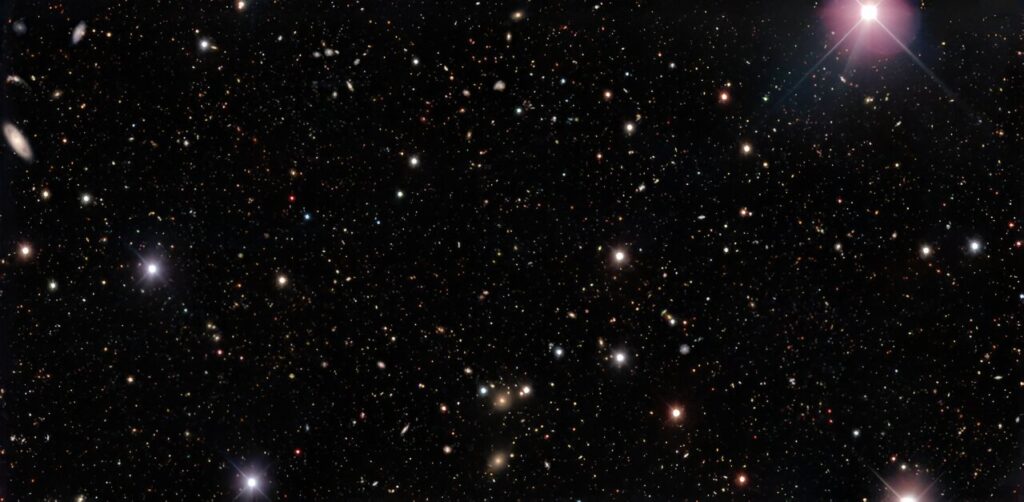Artificial intelligence helps scientists find quasar candidates in the early Universe. To do this, a specially trained machine learning algorithm will process telescope images in search of images distorted by gravitational lensing.

Quasars and gravitational lensing
The first sign that an object is a quasar is its red color. This should then be confirmed by individual observations of their spectra. However, some candidates with a high redshift may be mistakenly excluded from subsequent studies due to distortions in their appearance caused by gravitational lensing.
This phenomenon occurs when a massive object, such as a galaxy, is between us and a distant celestial body. The mass of the galaxy curves space, acting like a magnifying glass, causing the path that light travels from the distant object to be bent, and we get a distorted image of it.
While this alignment can be useful – a gravitational lens magnifies the image of a quasar, making it brighter and easier to detect – it can also deceptively change the appearance of a quasar. Interference from light from stars in the intervening lensing galaxy can make the quasar appear bluer, and spacetime curvature can make it appear blurry or diluted. Both of these effects make it a likely candidate for quasars.
Therefore, a team of astronomers led by Xander Byrne, an astronomer at the University of Cambridge and lead author of a paper presenting these results in the journal Monthly Notices of the Royal Astronomical Society, decided to recover the lensed quasars that had been missed in previous studies.
Searching for quasars distorted by gravitational lenses
Byrne set out to find these missing treasures in the vast Dark Energy Survey (DES) data archive. The DES was conducted using a dark energy camera mounted on the 4-meter Victor M. Blanco Telescope at the National Science Foundation’s Cerro Tololo Inter-American Observatory, part of the NSF NOIRLab program.
The challenge was to find these cosmic gems in a vast ocean of data.
The full DES dataset contains more than 700 million objects. Byrne reduced this archive by comparing the data with images from other surveys to filter out unlikely candidates, including objects that may have been brown dwarfs, which, despite being completely different from quasars in almost every way, can look surprisingly similar to quasars in images. This process resulted in a much more manageable dataset containing 7438 objects.
In searching for these 7438 objects, Byrne needed to be as efficient as possible, but he knew that traditional methods would likely miss the high redshift lensed quasars he was looking for. To avoid prematurely screening out lensed quasars, the scientists used a contrast learning algorithm.
Machine learning algorithm will search for quasars
Contrast learning is a type of artificial intelligence (AI) algorithm in which successive decisions assign each data point to a group according to what it is or is not. Byrne’s decision not to rely on human visual interpretation led him to think of an unsupervised AI process, meaning that the algorithm itself drives the learning process, not the human.
Supervised machine learning algorithms are based on a so-called ground truth defined by a human programmer. For example, the process may start with a description of a cat and move through decisions such as “This is/is not a picture of a cat. This is/is not a picture of a black cat.”
In contrast, unsupervised algorithms do not rely on an initial, human-given definition as the basis for their decisions. Instead, the algorithm sorts each data point by its similarity to other data points in the set. In this case, the machine will find similarities between images of several animals and group them as cats, dogs, giraffes, penguins, etc.
Starting with 7438 Byrne objects, the algorithm unsupervisedly sorted the objects into groups. Using a geographical analogy, the team called the data groups an archipelago. Within it, a small “island” subset of objects were grouped together as possible quasar candidates. Among these candidates, four stood out like pearls in a pile of stones.
Using archived data from the Gemini South telescope at the Gemini International Observatory, operated by the NSF NOIRLab, Byrne confirmed that 3 of the 4 candidates on the “quasar island” are indeed high redshift quasars. And one of them could very likely turn out to be the cosmic find Byrne was hoping to find – a gravitationally lensed high redshift quasar. The team is now planning further imaging to confirm the quasar’s nature.
Based on materials from phys.org

